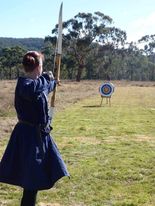You’ll need something to wear to your first “garbed” event (an event where clothing worn prior to 1600 is expected). The quickest and easiest way to do this to make a tunic or two.
In order to make a tunic follow the instructions below.
We recommend asking around at any of the regular events to get some ‘in person’ assistance. Information about events can be found at the Regular Events page.
Quick guidance
Tunics are worn by everyone throughout the entire period the SCA covers, until the mid-1300s pretty much all clothing is comprised of layers of tunics of various lengths and looseness / tightness. After the mid-1300s the tunic is made of white linen and is the underwear layer, and is hereafter known as a ‘smock’, ‘shirt’, ‘chemise’. No matter what period you want to cover you will need to make a tunic (or 7).
As a general rule of thumb for outerwear tunics men should aim for a knee length tunic and women should aim for a floor length tunic.
Try to make your tunics from natural fibres: wool, linen or cotton. You will be more comfortable in the heat, warmer in the cold and less likely to sustain serious injury if you clothes catch on fire over a flame / fire.
To make your tunics look good try layering two tunics, and decorating the cuffs, hem and neckline of the tunic in some way (see inspiration section below).
Above all, the SCA requires AN ATTEMPT at clothing that would have been worn prior to 1600. Whatever you make will be fine 🙂
Instructions
- Open the Elizabethan Smock Generator website (a smock is what the tunic turned into over time)
- Find a friend / relative, get a tailor’s measuring tape and take all the measurements listed on the website. Write them down on some note-paper. It’s better to have someone else take them for you as there are measurements you won’t be able to take accurately on your own.
- Input them into the pattern generator, choose the “pieced option” if you have experience sewing, and the “1-piece option” if you haven’t sewn much before. Note down how much fabric it says you will need. You can convert inches to cms and yards to metres on this site. Save the page, or re-enter the information at step 5.
- Find / buy this amount of fabric, take it home, wash it the same way you plan to wash the tunic(s) in future, which reduces possible future shrinkage (wash it separately, in case the dyes run on the first wash).
- Refer to the generated pattern, and cut out all the pieces following the instructions on the generator page
- Follow the instructions on this page to assemble the tunic. Exception: in step 4, make it a round neck opening, not a square one
- Wear it to an event and enjoy!
Inspiration
Photos of re-enactors in tunics for you to get ideas on what you would like to wear / make:
- An Italian photographer taking photos or re-enactment events: http://www.flickr.com/photos/nerogotico/sets/72157603262177678/
- A pinterest search for medieval tunics

